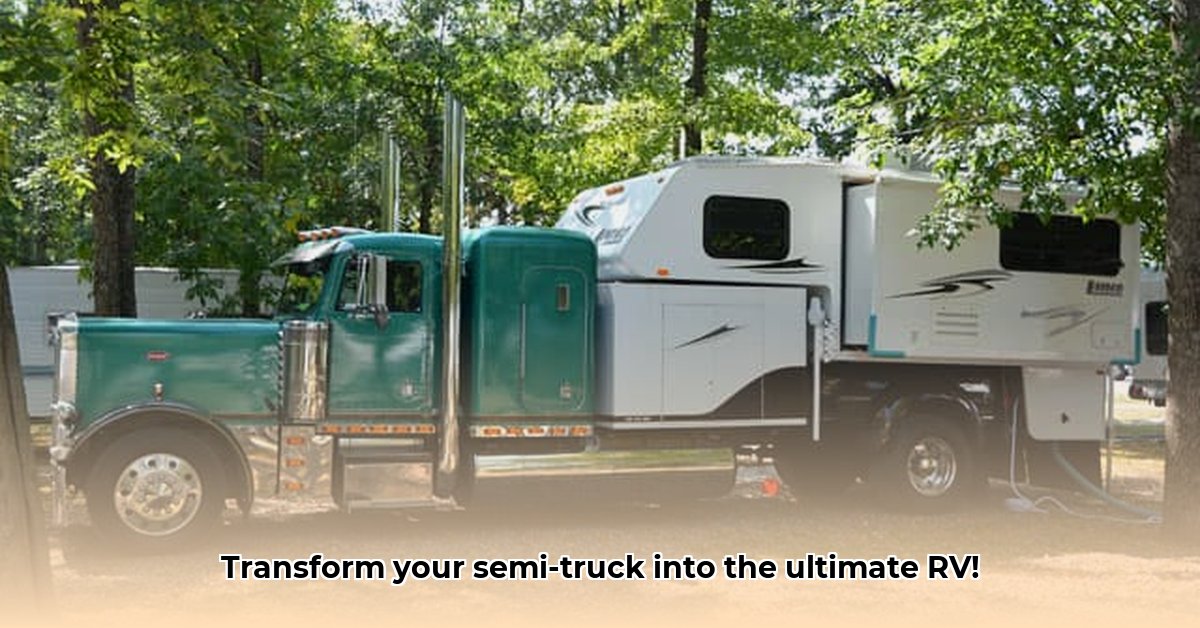
Turning a semi-truck into a luxurious, customized RV is a captivating project, offering unparalleled space and personalization. However, this ambitious undertaking requires meticulous planning, careful execution, and a firm grasp of the legal landscape. This guide provides a comprehensive roadmap to navigate the complexities of semi-truck RV conversions, ensuring a safe and successful outcome. For additional exterior modification ideas, check out these semi truck fenders.
Understanding the Allure of Semi-Truck RV Conversions
Why choose a semi-truck over a standard RV? The answer is simple: sheer scale and customization potential. Imagine a spacious interior, adaptable to your exact needs, and the ability to tow vehicles or large amounts of cargo. This unparalleled flexibility comes with significant challenges, but the rewards are substantial. Are you ready to embrace the undertaking?
Navigating the Legal Landscape: State Laws and Regulations
This is arguably the most critical aspect. Semi-truck RV conversion regulations vary dramatically by state. A legally compliant conversion in one state might be entirely illegal in another. Before starting any work, thoroughly research your state's Department of Motor Vehicles (DMV) regulations concerning modified vehicles and RV classifications. Failure to comply can result in hefty fines, impoundment, and legal battles. This step is non-negotiable.
The Conversion Process: A Step-by-Step Guide
Converting a semi-truck is a complex project often requiring professional assistance. Here's a structured approach:
- Finding Your Truck: Source a suitable semi-truck chassis, considering age, condition, and existing features. A thorough pre-purchase inspection by a qualified mechanic is vital.
- Comprehensive Inspection: A detailed mechanical assessment is crucial to identify necessary repairs or upgrades and uncover hidden problems. Obtain multiple professional opinions if possible.
- Detailed Blueprint: Create a comprehensive design encompassing interior layout, structural reinforcements, electrical and plumbing systems, insulation, and all other components – a meticulously detailed plan is your essential guide.
- The Conversion Build: This phase demands expertise in welding, carpentry, electrical work, and plumbing. Unless you possess these skills, engaging experienced contractors is strongly recommended.
- Rigorous Testing: After completion, thoroughly test every system to ensure functionality and identify any potential issues before hitting the road. This preventative measure saves significant time and expense later.
Key Mechanical Considerations: Avoiding Potential Pitfalls
Several mechanical aspects require special attention:
- Brakes: The increased weight necessitates a heavy-duty braking system; significant upgrades will almost certainly be required.
- Suspension: A robust suspension system is essential for safe handling and a smooth ride; modifications are likely needed.
- Electrical System: A powerful, reliable system is vital to power appliances; this may require new wiring or alternative power sources.
- Weight Distribution: Proper weight distribution is crucial for handling, fuel efficiency, and tire wear. Consult a professional for precise calculations.
Weighing the Pros and Cons: Is a Semi-Truck RV Right for You?
This conversion offers many advantages, but acknowledging the drawbacks is equally crucial.
| Feature | Pros | Cons |
|---|---|---|
| Space | Vast interior for personalized living. | Extensive time and effort for interior build-out and customization. |
| Towing Capacity | Exceptional towing capacity for vehicles or significant cargo. | Higher running costs due to size and fuel consumption. |
| Fuel Efficiency | Potentially more fuel-efficient than smaller RVs hauling similar loads. | Higher initial cost and ongoing fuel expense compared to conventional RVs. |
| Customization | Limitless personalization opportunities. | Requires specialized skills or professional assistance for a successful build. |
| Regulations | A significant regulatory hurdle, varying greatly by state/location. | Requires extensive research and strict adherence to applicable laws. |
Managing the Risks: A Proactive Approach
Unexpected issues can occur. Proactive planning minimizes their impact.
| Risk Factor | Likelihood | Impact | Mitigation |
|---|---|---|---|
| Mechanical Failure | Medium | High | Preventative maintenance; budget for repairs. |
| Legal Non-Compliance | High | Very High | Thorough legal research; professional legal counsel. |
| Poor Weight Distribution | Medium | Medium | Professional consultation; precise weight calculations. |
| Unexpected Conversion Costs | Medium | Medium | Detailed budget with a substantial contingency fund. |
Embarking on Your Semi-Truck RV Conversion: The Final Word
Converting a semi-truck into an RV is a challenging yet incredibly rewarding journey. Success depends on meticulous planning, precise execution, and unwavering commitment to safety and legal compliance. While the process is demanding, the freedom of the open road in a custom-built home makes it all worthwhile. The journey is long, but the destination is unique and truly unforgettable. Remember, thorough planning and attention to detail are paramount to success.